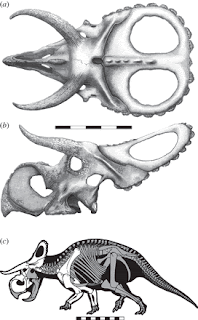(here's the link: http://rspb.royalsocietypublishing.org/content/280/1766/20131186
also, ooo! it's in the proceedings of the Royal Society, classy!)
Ok, so to the topic in question:
Nasutoceratops titusi or if you'd rather it in English, 'that there dino with a big nose, horn-face'. No seriously it translates as 'big nose, horn-face'.
Well, that certainly made the day of one of my friends who actually posted a link to it on Facebook which is where I first found the BBC article (link below). (Look, I make no apologies for using the BBC as a source, it's free online (unlike certain science magazines (I'm looking at you, New Scientist)) and easy to use and access. It also should be fairly unbiased which is what I look for in my science-related news stories.
Wow, I've got off topic, ok, Nasutoceratops.
Found in Utah in 2006 the fossil has only just been cleaned up and pieced back together well enough to discover that it's unlike any other triceratops that have been found before. The triceratops dated from the late Cretaceous period and like its lumbering herbivore triceratops cousins weights 2.5 tonnes.
I'd quote directly from the abstract of the journal article to tell you a little more about what the partial skeleton and skull that they found looked like but unfortunately I don't speak palaeontologist. So we're going to have to stick with it has a big nose and a horned face for now. However, to help matters, here's a picky of the beasty in question:
Figure 1: taken from the original journal paper (full reference below) this is a reconstruction of the skull from the fossil found.
It seems from the article that the purpose of the facial appendages are a matter of debate either for male competition as weapons or species identification or part of mating. Well, I'll leave that to the palaeontologists but its nice to see natural sciences (read, geology) make the news recently.
In other science news....
A gas cloud has been imaged spiralling into a black hole. Astrophysicists are hoping to get images of the cloud as its ripped apart by gravitation forces. The sadists. (Joke). (Link below)
In other news that I made up because I thought it sounded interesting...
OK, so genuinely this just happened ('just' being when I'm writing this). So I wanted to pluck a random journal article out of the aether to talk about so a quick bit of Science Direct searching later for some up to date (2013) articles with the search word as 'magma' has lead to none other than an article co-authored by a member of my own dept. at my University (!):
The rheology of two-phase magmas: A review and analysis
(rheology is just how something flows. From the Greek, rheos meaning flow)
Apart from the fact that this will be just perfect to read for my project next year here's a quick summary of the abstract and my cursory glance:
The paper addresses two different types of two-phase magma, one that is liquid and crystals and the other, liquid and gas (bubbles). It reviews the rheological analysis of each and presents numerical modelling techniques for calculating each.
Or to put it into newspaper headline speak:
"Scientists confirm their mathematical simplifications of physical processes marry up with their analogue simplifications of physicals processes. In some cases."
(Kind of reads like the headline of every science press release ever, right?)
More exciting geology news next time!
What do you call a dinosaur with no eyes? Do-you-think-he-saw-us
Sampson, S.D., Lund, E.K., Loewen, M.A., Farke, A.A., Clayton, K.E., 2013, A remarkable short-snouted horned dinosaur from the Late Cretaceous (late Campanian) of southern Laramidia, Proceedings of the Royal Society B (Biological Sciences), Vol. 280
BBC article on the dinosaur: http://www.bbc.co.uk/news/science-environment-23329193
BBC article on the black hole: http://www.bbc.co.uk/news/science-environment-23343563
Mader, H.M., Llewellin, E.W., Mueller, S.P., 2013, The rheology of two-phase magmas: A review and analysis, Journal of Volcanology and Geothermal Research, Vol. 257, p.135-158

